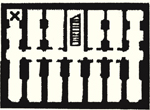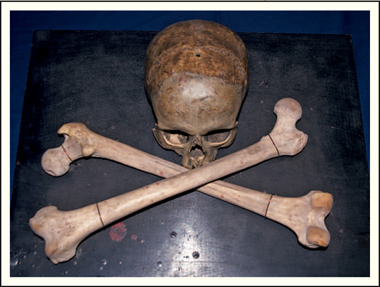
 HE WOODEN stairs descending to the Capitol’s subbasement were as steep and shallow as any stairs Langdon had ever traversed. His breathing was faster now, and his lungs felt tight. The air down here was cold and damp, and Langdon couldn’t help but flash on a similar set of stairs he had taken a few years back into the Vatican’s Necropolis. The City of the Dead.
HE WOODEN stairs descending to the Capitol’s subbasement were as steep and shallow as any stairs Langdon had ever traversed. His breathing was faster now, and his lungs felt tight. The air down here was cold and damp, and Langdon couldn’t help but flash on a similar set of stairs he had taken a few years back into the Vatican’s Necropolis. The City of the Dead.
Ahead of him, Anderson led the way with his flashlight. Behind Langdon, Sato followed closely, her tiny hands occasionally pressing into Langdon’s back. I’m going as fast as I can. Langdon inhaled deeply, trying to ignore the cramped walls on either side of him. There was barely room for his shoulders on this staircase, and his daybag now scraped down the sidewall.
“Maybe you should leave your bag above,” Sato offered behind him.
“I’m fine,” Langdon replied, having no intention of letting it out of his sight. He pictured Peter’s little package and could not begin to imagine how it might relate to anything in the subbasement of the U.S. Capitol.
“Just a few more steps,” Anderson said. “Almost there.”
The group had descended into darkness, moving beyond the reach of the staircase’s lone lightbulb. When Langdon stepped off the final wooden tread, he could feel that the floor beneath his feet was dirt. Journey to the center of the Earth. Sato stepped down behind him.
Anderson now raised his beam, examining their surroundings. The subbasement was less of a basement than it was an ultranarrow corridor that ran perpendicular to the stairs. Anderson shone his light left and then right, and Langdon could see the passage was only about fifty feet long and lined on both sides with small wooden doors. The doors abutted one another so closely that the rooms behind them could not have been more than ten feet wide.
ACME Storage meets the Catacombs of Domitilla, Langdon thought as Anderson consulted the blueprint. The tiny section depicting the subbasement was marked with an X to show the location of SBB13. Langdon couldn’t help but notice that the layout was identical to a fourteen-tomb mausoleum—seven vaults facing seven vaults—with one removed to accommodate the stairs they had just descended. Thirteen in all.

He suspected America’s “thirteen” conspiracy theorists would have a field day if they knew there were exactly thirteen storage rooms buried beneath the U.S. Capitol. Some found it suspicious that the Great Seal of the United States had thirteen stars, thirteen arrows, thirteen pyramid steps, thirteen shield stripes, thirteen olive leaves, thirteen olives, thirteen letters in annuit coeptis, thirteen letters in epluribus unum, and on and on.
“It does look abandoned,” Anderson said, shining the beam into the chamber directly in front of them. The heavy wooden door was wide open. The shaft of light illuminated a narrow stone chamber—about ten feet wide by some thirty feet deep—like a dead-end hallway to nowhere. The chamber contained nothing more than a couple of old collapsed wooden boxes and some crumpled packing paper.
Anderson shone his light on a copper plate mounted on the door. The plate was covered with verdigris, but the old marking was legible:
![]()
“SBB Four,” Anderson said.
“Which one is SBB Thirteen?” Sato asked, faint wisps of steam curling out of her mouth in the cold subterranean air.
Anderson turned the beam toward the south end of the corridor. “Down there.”
Langdon peered down the narrow passage and shivered, feeling a light sweat despite the cold.
As they moved through the phalanx of doorways, all of the rooms looked the same, doors ajar, apparently abandoned long ago. When they reached the end of the line, Anderson turned to his right, raising the beam to peer into room SBB13. The flashlight beam, however, was impeded by a heavy wooden door.
Unlike the others, the door to SBB13 was closed.
This final door looked exactly like the others—heavy hinges, iron handle, and a copper number plate encrusted with green. The seven characters on the number plate were the same characters on Peter’s palm upstairs.
![]()
Please tell me the door is locked, Langdon thought.
Sato spoke without hesitation. “Try the door.”
The police chief looked uneasy, but he reached out, grasped the heavy iron handle, and pushed down on it. The handle didn’t budge. He shone the light now, illuminating a heavy, old-fashioned lock plate and keyhole.
“Try the master key,” Sato said.
Anderson produced the main key from the entry door upstairs, but it was not even close to fitting.
“Am I mistaken,” Sato said, her tone sarcastic, “or shouldn’t Security have access to every corner of a building in case of emergency?”
Anderson exhaled and looked back at Sato. “Ma’am, my men are checking for a secondary key, but—”
“Shoot the lock,” she said, nodding toward the key plate beneath the lever.
Langdon’s pulse leaped.
Anderson cleared his throat, sounding uneasy. “Ma’am, I’m waiting for news on a secondary key. I am not sure I’m comfortable blasting our way into—”
“Perhaps you’d be more comfortable in prison for obstructing a CIA investigation?”
Anderson looked incredulous. After a long beat, he reluctantly handed the light to Sato and unsnapped his holster.
“Wait!” Langdon said, no longer able to stand idly by. “Think about it. Peter gave up his right hand rather than reveal whatever might be behind this door. Are you sure we want to do this? Unlocking this door is essentially complying with the demands of a terrorist.”
“Do you want to get Peter Solomon back?” Sato asked.
“Of course, but—”
“Then I suggest you do exactly what his captor is requesting.”
“Unlock an ancient portal? You think this is the portal?”
Sato shone the light in Langdon’s face. “Professor, I have no idea what the hell this is. Whether it’s a storage unit or the secret entrance to an ancient pyramid, I intend to open it. Do I make myself clear?”
Langdon squinted into the light and finally nodded.
Sato lowered the beam and redirected it at the door’s antique key plate. “Chief? Go ahead.”
Still looking averse to the plan, Anderson extracted his sidearm very, very slowly, gazing down at it with uncertainty.
“Oh, for God’s sake!” Sato’s tiny hands shot out, and she grabbed the weapon from him. She stuffed the flashlight into his now empty palm. “Shine the damned light.” She handled the gun with the confidence of someone who had trained with weapons, wasting no time turning off the pistol’s safety, cocking the weapon, and aiming at the lock.
“Wait!” Langdon yelled, but he was too late.
The gun roared three times.
Langdon’s eardrums felt like they had exploded. Is she insane?! The gunshots in the tiny space had been deafening.
Anderson also looked shaken, his hand wavering a bit as he shone the flashlight on the bullet-riddled door.
The lock mechanism was now in tatters, the wood surrounding it entirely pulverized. The lock had released, the door now having fallen ajar.
Sato extended the pistol and pressed the tip of the barrel against the door, giving it a push. The door swung fully into the blackness beyond.
Langdon peered in but could see nothing in the darkness. What in the world is that smell? An unusual, fetid odor wafted out of the darkness.
Anderson stepped into the doorway and shone the light on the floor, tracing carefully down the length of the barren dirt floor. This room was like the others—a long, narrow space. The sidewalls were rugged stone, giving the room the feel of an ancient prison cell. But that smell …
“There’s nothing here,” Anderson said, moving the beam farther down the chamber floor. Finally, as the beam reached the end of the floor, he raised it up to illuminate the chamber’s farthest wall.
“My God … !” Anderson shouted.
Everyone saw it and jumped back.
Langdon stared in disbelief at the deepest recess of the chamber.
To his horror, something was staring back.

 HAT IN God’s name … ?” At the threshold of SBB13, Anderson fumbled with his light and retreated a step.
HAT IN God’s name … ?” At the threshold of SBB13, Anderson fumbled with his light and retreated a step.
Langdon also recoiled, as did Sato, who looked startled for the first time all night.
Sato aimed the gun at the back wall and motioned for Anderson to shine the light again. Anderson raised the light. The beam was dim by the time it reached the far wall, but the light was enough to illuminate the shape of a pallid and ghostly face, staring back at them through lifeless sockets.
A human skull.
The skull sat atop a rickety wooden desk positioned against the rear wall of the chamber. Two human leg bones sat beside the skull, along with a collection of other items that were meticulously arranged on the desk in shrinelike fashion—an antique hourglass, a crystal flask, a candle, two saucers of pale powder, and a sheet of paper. Propped against the wall beside the desk stood the fearsome shape of a long scythe, its curved blade as familiar as that of the grim reaper.

THE SKULL AND CROSSBONES
36.1: Doug Blane (www.DougBlane.com)/Alamy
Sato stepped into the room. “Well, now … it appears Peter Solomon keeps more secrets than I imagined.”
Anderson nodded, inching after her. “Talk about skeletons in your closet.” He raised the light and surveyed the rest of the empty chamber. “And that smell?” he added, crinkling his nose. “What is it?”
“Sulfur,” Langdon replied evenly behind them. “There should be two saucers on the desk. The saucer on the right will contain salt. And the other sulfur.”
Sato wheeled in disbelief. “How the hell would you know that?!”
“Because, ma’am, there are rooms exactly like this all over the world.”
One story above the subbasement, Capitol security guard Nuñez escorted the Architect of the Capitol, Warren Bellamy, down the long hallway that ran the length of the eastern basement. Nuñez could have sworn that he had just heard three gunshots down here, muffled and underground. There’s no way.
“Subbasement door is open,” Bellamy said, squinting down the hallway at a door that stood ajar in the distance.
Strange evening indeed, Nuñez thought. Nobody goes down there. “I’ll be glad to find out what’s going on,” he said, reaching for his radio.
“Go back to your duties,” Bellamy said. “I’m fine from here.”
Nuñez shifted uneasily. “You sure?”
Warren Bellamy stopped, placing a firm hand on Nuñez’s shoulder. “Son, I’ve worked here for twenty-five years. I think I can find my way.”